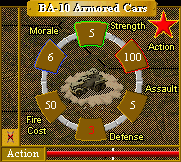
Game Statistics

|
| Victory Points |
Armour | Start | Start | End | End | ||
| Front | Side | Rear | Month | Year | Month | Year | |
| 3 | 3 | 1 | 1 | 11 | 39 | 12 | 43 |
| BA-10 Armored Car | ||||||||||||||||||||
| RANGE | 1 | 2 | 3 | 4 | 5 | 6 | 7 | 8 | 9 | 10 | 11 | 12 | 13 | 14 | 15 | 16 | 17 | 18 | 19 | 20 |
| HARD | 8 | 5 | 2 | . | . | . | . | . | . | . | . | . | . | . | . | . | . | . | . | . |
| SOFT | 6 | 5 | 4 | 3 | 2 | . | . | . | . | . | . | . | . | . | . | . | . | . | . | . |
History
|
|
|
Specification |
|
The BA-10 was built on a GAZ-AAA chassis. Installation of a 73-TK-1 radio took place, and these vehicles were designated BA-10M. Also, a railway vehicle was built known as BA-10ZD. About 1.400 BA-10 including all variants were built. China, Mongolia and Turkey may have used the BA-10 in service. Finland captured more than 20 BA-10, especially during the Winter War. Three BA-10 was sold to the Swedish Army by the Finns where they were tested as command vehicles known as Pansarbil m/31F. In 1941/42, Germany captured many BA-10 and used them with infantry, police and training units as Panzerspähwagen BAF 203(r). |